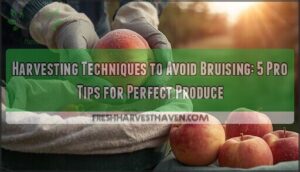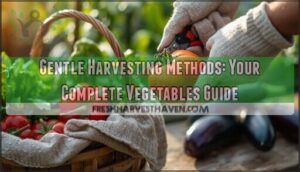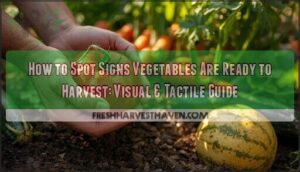This site is supported by our readers. We may earn a commission, at no cost to you, if you purchase through links.

Harvest during cool morning hours when fruits are firm, not during hot afternoons when they’re more susceptible. Choose the right equipment and maintain proper calibration to reduce mechanical damage. Pay attention to vulnerable crops like apples, peaches, and strawberries that bruise easily.
Smart timing, gentle handling, and proper tools can cut your bruise rates by 80%. The secret lies in understanding the five types of bruising and how each harvesting decision impacts your bottom line.
Table Of Contents
- Key Takeaways
- Key Causes of Bruising During Harvest
- Best Timing for Gentle Harvesting
- Gentle Handling and Picking Techniques
- Reducing Mechanical Damage in Transport
- Optimizing Post-Harvest Handling and Storage
- Frequently Asked Questions (FAQs)
- What are the best ways to prevent bruising?
- What causes bruising in potatoes?
- What causes fruit to bruise?
- How does weather affect harvest bruising rates?
- What container materials best prevent fruit damage?
- Should different crops use separate harvesting crews?
- How do you train workers in bruising prevention?
- What transportation methods minimize produce damage during shipping?
- How does weather affect fruit bruising susceptibility?
- What role does soil moisture play in bruising?
- Conclusion
Key Takeaways
- Harvest during cool morning hours when fruits have higher moisture content and firmer cell walls – you’ll cut bruising rates by up to 80% compared to hot afternoon picking, when produce becomes more susceptible to damage.
- Keep drop heights under 8 inches and use soft-padded buckets during collection – this simple change prevents picking bruises that cause most harvest damage and protects your crops like premium goods.
- Train your crew in gentle handling techniques, since rough handling creates the biggest bruising problems – workers need to understand that careful techniques directly impact your bottom line and crop quality.
- Choose proper equipment with wide tires and maintain smooth transport routes to reduce mechanical damage – low-impact tractors and padded containers can slash compression bruising during transport and storage.
Key Causes of Bruising During Harvest
You’ll encounter two main types of harvest bruising that can damage your crop’s value and shelf life. Picking bruises result from rough handling and impacts during harvest, while compression bruises occur from vibrations and pressure during transport and storage.
Types of Bruising (Picking, Compression, Pressure, Shatter, Blackspot)
You’ll encounter five distinct bruising types during harvest. Picking bruises result from rough handling and excessive force. Compression bruises develop from vibrations during transport. Pressure bruises form when fruit experiences prolonged weight or crushing.
Shatter bruises create visible skin cracks from impact damage. Blackspot bruising damages internal cells while keeping skin intact, making detection tricky.
Factors Contributing to Bruising (Handling, Transport, Equipment)
Poor handling creates the biggest bruising headaches during harvest operations. Rough handling during picking, excessive transport vibration on bumpy roads, and improperly calibrated harvesting equipment all contribute to damaged produce. Without proper operator training, workers unknowingly increase handling impact through careless techniques.
Storage conditions matter too—inadequate cooling systems and poor ventilation accelerate bruise development after harvest.
Identifying Susceptible Crops and Cultivars
Not all crops face equal bruising risks. Apples, peaches, potatoes, and strawberries show high Storage Susceptibility due to soft flesh and delicate skin.
Cultivar Bruise Resistance varies considerably – Russet Burbank potatoes bruise easily while Lady Rosetta shows Genetic Predisposition to damage. Varietal Differences matter too: ‘Radiance’ strawberries bruise more than ‘Sweet Sensation’.
Understanding these traits helps you choose resilient cultivars and adjust bruise management strategies accordingly. Bruising can lead to increased ethylene production, accelerating ripening.
Best Timing for Gentle Harvesting
You’ll get the best harvest when you time your picking to match your crop’s natural rhythms, generally during early morning hours when plants have higher moisture content and firmer cell walls.
The key is harvesting when your produce has reached proper maturity but before skin becomes too tender, which you can assess by checking for firm skin set and appropriate color development.
Early Morning Vs. Late Evening Harvests
Looking for the best timing to minimize bruising? Temperature effects and turgor pressure fluctuations make harvest timing essential for bruise prevention.
Here’s when to schedule your harvest for ideal timing:
- Early morning hours – Cool temperatures maintain higher turgor pressure, reducing tuber bruising and mechanical damage
- Late evening periods – Lower sunlight exposure keeps produce firm while worker comfort during extended operations
- Avoid midday heat – High temperatures reduce cell wall integrity, increasing susceptibility to harvest management problems
Aligning Harvest With Crop Energy Rhythms
Your crops’ internal clocks control when cells are strongest and most resistant to bruising. Harvesting during natural energy peaks—generally mid-morning when photosynthesis surges—can reduce damage by up to 89%. Match your timing to when plants store maximum energy for better fruit quality. Understanding biological cycles is key for optimizing harvest times.
| Crop Type | Peak Energy Window | Bruising Risk Level |
|---|---|---|
| Stone Fruits | 9-11 AM | Low during energy peaks |
| Leafy Greens | 7-9 AM | Minimal with proper timing |
| Root Vegetables | 10 AM-12 PM | Reduced cell wall damage |
| Berries | 8-10 AM | Lower susceptibility window |
Assessing Crop Readiness and Skin Set
Proper crop readiness assessment prevents costly harvest mistakes. You’ll know when fruit and vegetables reach peak timing by checking key maturity indicators. Check skin firmness by gently pressing – ready produce should resist without yielding. Test starch levels and sugar content using field instruments for accurate readings.
- Skin Set Assessment – Examine potato tubers for firm, set skin that won’t rub off easily
- Color Changes – Watch for natural color development indicating peak maturity
- Firmness Testing – Apply gentle pressure to gauge skin strength and bruise prevention readiness
- Field Sampling – Test multiple specimens across harvesting areas for consistent maturity
Gentle Handling and Picking Techniques
You’ll prevent most picking bruises by using soft-padded buckets and keeping drop heights under 20 cm, which can reduce bruise rates by up to 89%.
Soft-padded buckets and drop heights under 20 cm can reduce harvest bruise rates by up to 89%
Train your field workers to handle fruit gently and secure their equipment properly, since rough handling during harvest causes the majority of damage you’ll see later.
Using Proper Harvesting Tools and Buckets
Your harvesting bucket matters more than you think. Choose containers with soft, padded interiors to cushion fruit during collection. Quality container material withstands repeated use without cracking or developing sharp edges that damage produce.
Aluminum three-legged ladders prevent tree damage while supporting stable picking. Ergonomic tools reduce hand fatigue during long harvest days. Regular tool maintenance keeps equipment functioning smoothly.
Preventing Excessive Force and Drop Heights
During the harvesting process, keep drop heights under 20 centimeters to reduce bruising by up to 89%. Use padded harvesting tools and gentle transfer systems to minimize damage.
Apply controlled fruit placement techniques rather than dropping produce into containers. Force reduction methods include cushioning impact surfaces and avoiding excessive pressure during handling to protect your harvest quality.
Field Worker Training and Supervision
Beyond just having the right tools, your field hands need solid Picking Technique Training and Active Supervision to prevent bruising. Start with Gentle Handling basics and Ladder Safety protocols.
Train truck drivers on proper loading methods. Implement Incentive Programs that reward careful harvesting techniques.
A thorough bruise management program with ongoing supervision ensures your team consistently delivers quality produce.
Reducing Mechanical Damage in Transport
You’ll lose up to 13% of your harvest to transport damage if you don’t choose the right equipment and methods.
The key is selecting low-impact tractors with wide tires, using padded containers, and maintaining smooth surfaces to reduce vibrations that cause compression bruising.
Choosing and Calibrating Harvesting Equipment
Equipment calibration makes or breaks your bruise management program. Air harvesters and precision harvesters can slash bruise rates below 10% when properly adjusted.
Match your harvester conveyor speeds with ground speed – mismatched speeds increase bruising by 5-12%. Use calibration tools like SmartSpud to identify pressure points.
Adjust blade depth, conveyor angles, and roller pressure for each crop variety you’re harvesting.
Tractor and Vehicle Selection for Lower Bruising
Your tractor choice directly impacts harvest quality. Low-profile orchard tractors with wide tires distribute weight better, reducing energy transfer to fruit.
Maintain proper tire pressure and moderate vehicle speed during transport. Check suspension systems regularly to absorb road vibrations.
Plan smooth routes through orchards, avoiding rough terrain that increases bruising risk through excessive bouncing and jarring movements.
Protective Packaging and Container Use
Bubble-wrap liners and padded containers act like shock absorbers for your harvest. Choose rigid bins with soft interior padding to prevent fruit damage during transport.
Foam inserts and controlled atmosphere packaging maintain quality while reducing bruising by up to 60%.
Stack pallets carefully to make certain of stability and minimize vibration transfer throughout the journey.
Optimizing Post-Harvest Handling and Storage
Once you’ve got your produce safely off the field, proper post-harvest handling becomes your last line of defense against bruising and quality loss. You’ll need to focus on immediate cooling, controlled storage conditions, and maintaining sanitation standards to preserve the hard work you’ve put into gentle harvesting techniques.
Cooling and Ventilation Practices
After harvest, rapid cooling becomes your produce’s best friend. Pre-cooling methods like forced-air systems drop temperatures fast, cutting bruise rates dramatically. Temperature monitoring ensures consistent cooling, while proper ventilation design prevents hot spots that weaken fruit.
- Forced-air cooling – Reduces field heat within hours, not days
- Strategic ventilation – Creates uniform airflow throughout storage areas
- Humidity control – Maintains 90-95% levels to preserve firmness
- Energy efficiency – Smart cooling saves money while protecting quality
- Temperature control – Keeps tuber temperature stable for potato storage
Moisture and Respiration Control
Within your storage environment, ideal humidity levels between 90-95% prevent dehydration, while controlled atmosphere systems regulate respiration rates. Monitor condensation prevention to avoid surface moisture that encourages decay. Proper tuber hydration extends storage duration considerably.
Potato storage requires careful humidity management to rehydrate tubers without creating excess moisture that promotes rot.
| Storage Factor | Optimal Range | Impact on Quality |
|---|---|---|
| Humidity | 90-95% | Prevents skin shrinkage |
| Temperature | 38-40°F | Slows respiration rates |
| Air Circulation | Continuous gentle | Reduces condensation |
Sanitation and Storage Area Preparation
Clean storage areas prevent contamination that compromises harvest quality. Warehouse sanitation starts with proper surface disinfection before handling tubers. Your loading area becomes the foundation for maintaining potato quality throughout storage.
- Disinfect all surfaces with approved sanitizers before storing produce
- Install temperature monitoring systems to track storage conditions consistently
- Implement controlled atmosphere protocols to improve storage environments
- Establish thorough pest control measures around storage facilities
- Create designated pathways to minimize cross-contamination during handling
Regular Evaluation and Equipment Maintenance
Your harvesting process needs regular checkups to minimize damage and maintain potato quality. Set maintenance schedules every two weeks for harvester equipment and loading equipment.
Conduct damage assessment after each harvest day, checking for wear patterns that affect calibration frequency.
Implement operator training monthly to make certain of proper handling techniques.
Perform cost analysis quarterly to justify equipment upgrades and repairs.
Frequently Asked Questions (FAQs)
What are the best ways to prevent bruising?
Like walking on eggshells, you’ll need gentle handling and proper equipment. Use padded containers, reduce drop heights below 20cm, train workers properly, maintain smooth transport surfaces, and implement careful supervision during all handling stages.
What causes bruising in potatoes?
Potato bruising happens through four main ways: blackspot damage from impacts that crush internal cells, shatter bruising from rough handling creating skin cracks, pressure bruising from weight compression, and skinning from handling immature tubers.
What causes fruit to bruise?
Rough handling hits fruit like a hammer blow, damaging cells beneath the skin. You’ll see bruising from impacts during picking, compression from weight, and vibrations during transport that break delicate tissue.
How does weather affect harvest bruising rates?
Weather conditions dramatically affect bruising rates during harvest. Temperature and humidity influence fruit’s susceptibility to bruises.
Harvesting during warmer parts causes faster aging. You’ll see fewer bruises when picking in cool, humid conditions.
What container materials best prevent fruit damage?
Think of containers as armor for your fruit. You’ll want padded buckets with soft interiors, bubble liners in bins, and cushioned surfaces on conveyors.
These materials absorb impact energy that would otherwise bruise your harvest.
Should different crops use separate harvesting crews?
Yes, you should use separate crews for different crops. Each crop has unique handling requirements, ripeness indicators, and damage thresholds.
Specialized crews develop crop-specific skills and reduce bruising through proper techniques.
How do you train workers in bruising prevention?
Like teaching someone to ride a bike, you’ll need hands-on practice sessions. Start with demonstrations showing proper fruit handling techniques.
Use role-playing exercises where workers practice gentle picking motions. Provide immediate feedback during training.
Create simple visual guides showing correct versus incorrect handling methods.
What transportation methods minimize produce damage during shipping?
You’ll want padded containers, smooth transport routes, and cushioned conveyor systems.
Keep drop heights under 20 centimeters, use bubble liners in bins, and choose tractors with wide tires for gentler vibration control.
How does weather affect fruit bruising susceptibility?
Weather acts like your fruit’s invisible enemy – high temperatures and humidity make produce more vulnerable to bruising damage.
You’ll notice softer, more fragile fruit during hot spells and wet conditions.
What role does soil moisture play in bruising?
Soil moisture directly impacts fruit turgidity, which affects bruising susceptibility. Well-hydrated fruits have firmer cell walls that resist damage better. You’ll notice less bruising when you maintain consistent soil moisture throughout the growing season.
Conclusion
Despite seeming time-consuming, these harvesting techniques to avoid bruising actually save you money by reducing crop losses. Master gentle handling methods, harvest during cool morning hours, and invest in proper equipment to protect your investment.
Your workers need training on drop heights and soft-touch techniques. Remember that prevention costs less than losses – a single bruised apple bin can cost hundreds in rejected produce.
These proven strategies will dramatically improve your harvest quality and profitability.
- https://agric4profits.com/strategies-for-reducing-post-harvest-losses-in-agriculture/
- https://www.walshmedicalmedia.com/open-access/optimizing-harvesting-techniques-for-improved-yield-and-quality-of-agricultural-crops.pdf
- https://www.researchgate.net/publication/331952270_Strategies_to_Reduce_Post-Harvest_Losses_for_Fruits_and_Vegetables
- https://www.sciencedirect.com/science/article/pii/S2468014119301943
- https://www.farmstandapp.com/67456/7-strategies-for-reducing-harvest-losses/



